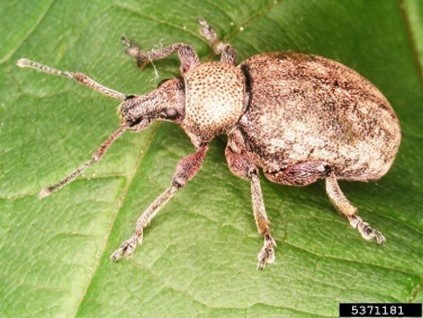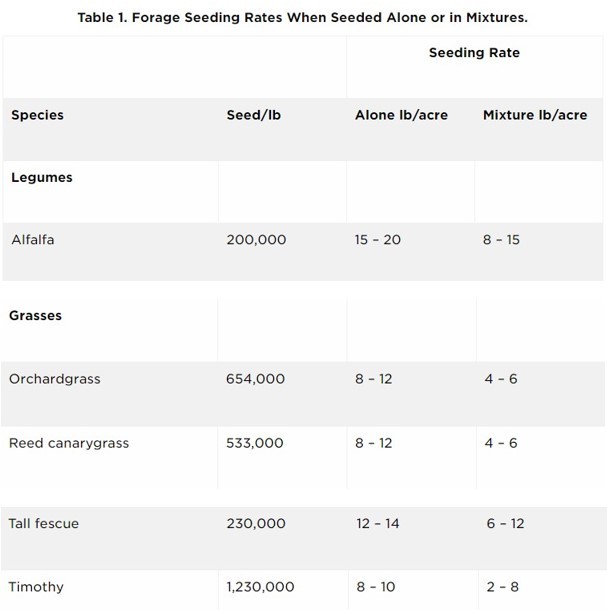Consideration for Alfalfa-Grass Mixtures
Katelyn Miller, Field Crops and Forage Specialist
Southwest New York Dairy, Livestock and Field Crops Program
85% of the acreage with alfalfa is planted as a mix with grass in the Northeast. Planting a mixture allows for two things: the accommodation of variable soil drainage throughout a field and the ability to optimize yield. Both species, alfalfa and grass, will thrive depending on various weather conditions. For example, last year's drought conditions meant that in many fields, the alfalfa was more present than the grass, regardless of seeding rate used during establishment. This is because the taproot on alfalfa was able to reach far enough down into the soil profile to acquire water. Although grasses have shorter roots, they can spread more effectively, filling in sparse areas to help reduce erosion, and are more likely to survive in low spots and wet areas throughout the field. Another reason that mixes are commonly used is to optimize yield and quality when planting on ground not well-suited to alfalfa. Not all land can support a pure alfalfa stand, so utilizing a mix will allow at least one of the species to thrive based on variable soil conditions and weather.
PROS:
- longer stand life
- less winterkill
- less traffic damage
- fewer pests and disease
- improved soil health
CONS:
- variable forage quality
- limited weed control
- timing harvest
If you're considering using a mix, some questions to ask include:
- Do you have less than premium quality alfalfa land?
- Do you have alfalfa snout beetle?
- Can you separate forages by quality in storage?
- Does your nutritionist believe in alfalfa-grass?
- Are you willing to invest more in forage and feeding management?
An adult Alfalfa Snout Beetle is shown below. For more information about this pest, visit https://cals.cornell.edu/field-crops/forages/insects-forage-crops/alfalfa-snout-beetle.

Grass species typically used in alfalfa-grass mixes include orchard grass, fescues, reed canarygrass, and timothy. One of the complications of using an alfalfa-grass mix is managing harvest timing and forage quality. To adapt to this, some desirable traits to look for in grasses are a later heading date to match maturity timing with alfalfa, and the ability to handle a more intensive cutting schedule. Let's take a look at the qualities of these grasses, and evaluate their suitability for an alfalfa-grass mix.
- Orchard grass is known for its early heading date, especially in the spring. This poses challenges for forage quality because if you harvest the forage when the alfalfa is at a suitable maturity, you have passed the quality parameters of the grass and you will have a lower quality mix.
- Fescues include both tall fescue and meadow fescue, which are relatively well-suited to be planted in a mix. They both mature in closer proximity to alfalfa and can handle an intensive cutting schedule. An important factor to consider is seeding rate when using fescues because it can be more aggressive in its growth in comparison to alfalfa.
- Reed canarygrass has similar harvest qualities to fescues, but it is actually one of the most aggressive grasses you can mix with alfalfa. Although reed canarygrass is slow to establish, within 2-3 years, it will begin to outcompete alfalfa. This makes it a good option to use for short-term rotations.
- Timothy prefers growing in cooler temperatures, making it a grass not well-suited to mix with alfalfa. Not only does it not produce much forage in the hot, summer months, but it's similar to orchard grass in that the timing of harvest does not match well to alfalfa.
Something important to note is that these factors can change not only from season to season, but also in your specific growing climate. There are ways to manage grasses that allow alfalfa a competitive edge if you notice that the percentage of grass in your field is increasing. To reduce the grass percentage in a field, the biggest management option is changing cutting height (within reason of course). Lowering your cutting height by a half-inch to an inch can help to cut back grass growth temporarily, allowing for the alfalfa to get a head start. Be careful not to set the cutting height too low, or there will be additional ash and contaminants in your feed. It is not recommended to do this practice often, since low cuttings done frequently can affect the overall survivability of the grass. Refer to the chart below for common seeding rates of these grasses, both on their own and in a mix. Meadow Fescue, which was mentioned above, is usually not seeded on its own. Utilize a seeding rate is 4-5 pounds/acre when in an alfalfa mixture.

Table is from https://www.canr.msu.edu/news/....
You can also use tools like those available on https://forages.org/. This website provides recommendations on seeding rates based on factors such as drainage, forage use, and intended livestock being fed. By filling in the website information, you can select fields you are planning to seed down and will receive not only recommended seeding rates, but also which forages will be best suited to property characteristics.

Upcoming Events
Cover Crop Breeding Field Walk
May 1, 2024
Freeville, NY
You're invited to join us for a Cover Crop Breeding Field Walk!
The Cover Crop Breeding Network breeds fall-sown cover crops for traits like fall emergence, winter survival, spring vigor, high biomass, hard seed, and non-shattering pods
Join us to walk the trial fields, talk about what we're seeing (and not seeing), hear about past years' results, and learn about CCB lines approaching commercialization.
Advanced line trials - Crimson clover, hairy vetch, winter pea, and winter canola
Planting date trials - Cereal rye and winter pea
Breeding nurseries - Cereal rye and winter pea (across the road & optional!)
Meat Your Farmer 2024
May 2, 2024 : Meat Your Farmer 2024
East Aurora, NY
This event brings together livestock farmers and the community to learn about local bulk meat sales and to taste recipes created for NYS schools, featuring meats from local farms. We are currently looking for farmers to participate in the event!
Western NY Value-Added Dairy Discussion Group: Jess May- Farm Credit East Webinar
May 2, 2024
We will start our Value-Added Dairy Processing discussion group series with a guest speaker from Farm Credit East. On May 2nd at noon, Jess May will join us to discuss the lender's point of view for on-farm processing and diversification. This is free to join and will be recorded.
Announcements
No announcements at this time.





